A Study on Victimization of Lower Black Working-Class Men
VerifiedAdded on 2024/05/05
|39
|6885
|270
Essay
AI Summary
This essay examines the victimization of lower Black working-class men in society, focusing on the various forms of victimization they experience, including racial discrimination, economic marginalization, and social stigmatization. It employs a mixed-methods approach, combining quantitative surveys and qualitative interviews to understand the patterns and personal experiences of victimization. The study investigates the economic reasons behind this victimization, comparing the experiences of lower-class Black working-class men with other populations. It assesses the impact of victimization on their standards of life, including psychological and physical health, educational attainment, and work opportunities. The essay also proposes policy recommendations and initiatives to combat the abuse of lower-class Black working-class men, aiming to promote equity and improve their overall well-being. This research contributes to a comprehensive understanding of the challenges faced by this marginalized group and offers practical guidance for addressing systemic injustices.
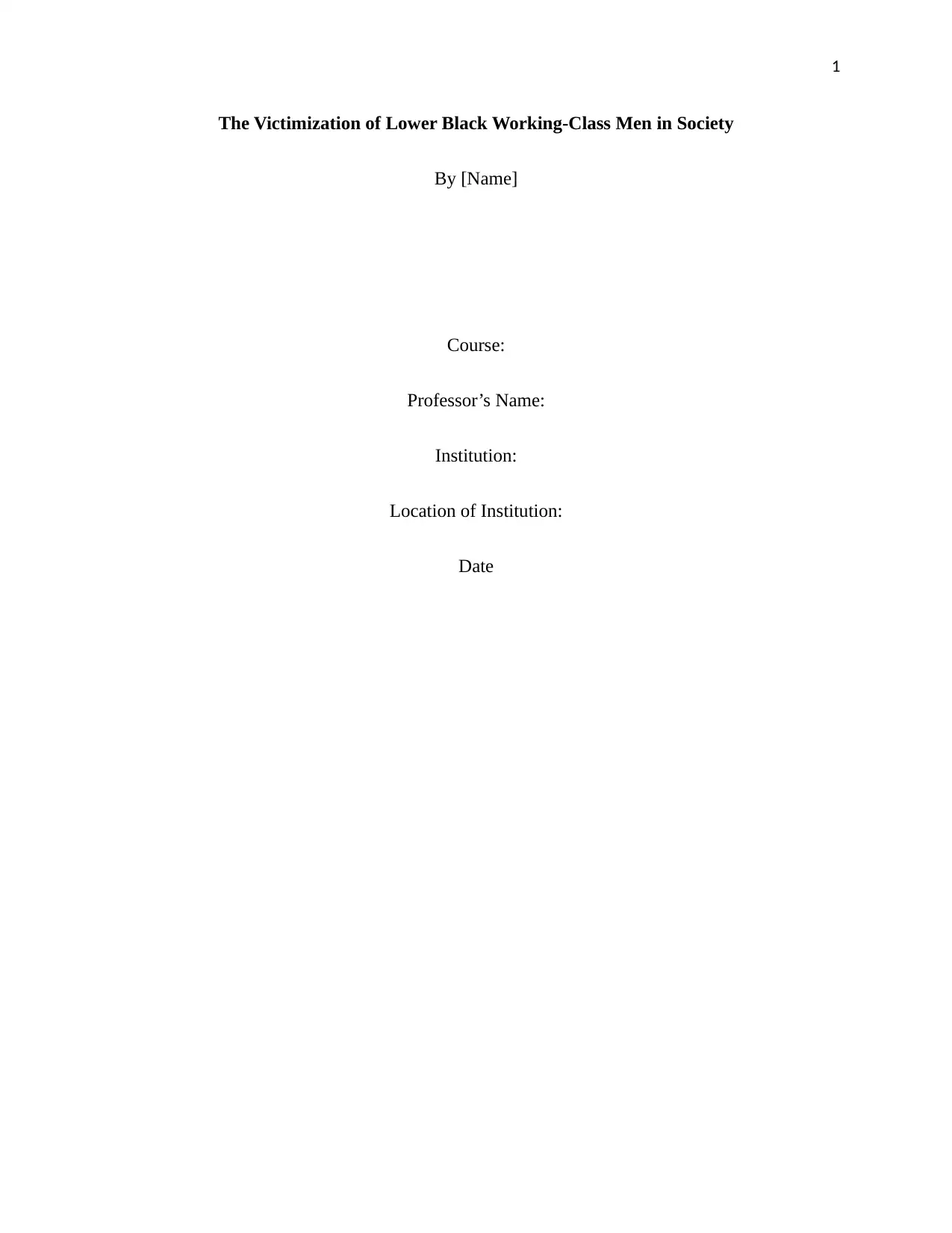
1
The Victimization of Lower Black Working-Class Men in Society
By [Name]
Course:
Professor’s Name:
Institution:
Location of Institution:
Date
The Victimization of Lower Black Working-Class Men in Society
By [Name]
Course:
Professor’s Name:
Institution:
Location of Institution:
Date
Paraphrase This Document
Need a fresh take? Get an instant paraphrase of this document with our AI Paraphraser
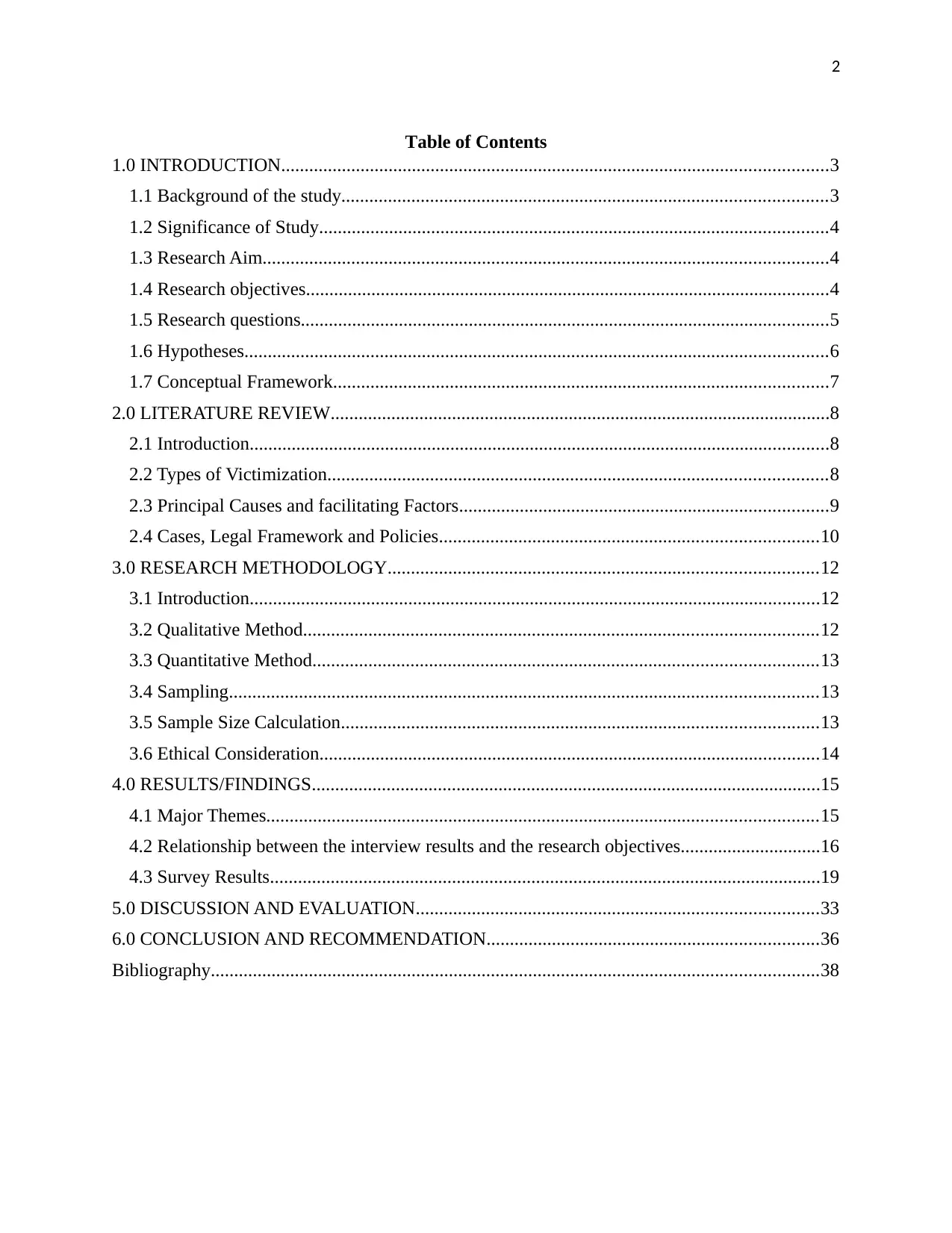
2
Table of Contents
1.0 INTRODUCTION.....................................................................................................................3
1.1 Background of the study........................................................................................................3
1.2 Significance of Study.............................................................................................................4
1.3 Research Aim.........................................................................................................................4
1.4 Research objectives................................................................................................................4
1.5 Research questions.................................................................................................................5
1.6 Hypotheses.............................................................................................................................6
1.7 Conceptual Framework..........................................................................................................7
2.0 LITERATURE REVIEW...........................................................................................................8
2.1 Introduction............................................................................................................................8
2.2 Types of Victimization...........................................................................................................8
2.3 Principal Causes and facilitating Factors...............................................................................9
2.4 Cases, Legal Framework and Policies.................................................................................10
3.0 RESEARCH METHODOLOGY............................................................................................12
3.1 Introduction..........................................................................................................................12
3.2 Qualitative Method..............................................................................................................12
3.3 Quantitative Method............................................................................................................13
3.4 Sampling..............................................................................................................................13
3.5 Sample Size Calculation......................................................................................................13
3.6 Ethical Consideration...........................................................................................................14
4.0 RESULTS/FINDINGS.............................................................................................................15
4.1 Major Themes......................................................................................................................15
4.2 Relationship between the interview results and the research objectives..............................16
4.3 Survey Results......................................................................................................................19
5.0 DISCUSSION AND EVALUATION......................................................................................33
6.0 CONCLUSION AND RECOMMENDATION.......................................................................36
Bibliography..................................................................................................................................38
Table of Contents
1.0 INTRODUCTION.....................................................................................................................3
1.1 Background of the study........................................................................................................3
1.2 Significance of Study.............................................................................................................4
1.3 Research Aim.........................................................................................................................4
1.4 Research objectives................................................................................................................4
1.5 Research questions.................................................................................................................5
1.6 Hypotheses.............................................................................................................................6
1.7 Conceptual Framework..........................................................................................................7
2.0 LITERATURE REVIEW...........................................................................................................8
2.1 Introduction............................................................................................................................8
2.2 Types of Victimization...........................................................................................................8
2.3 Principal Causes and facilitating Factors...............................................................................9
2.4 Cases, Legal Framework and Policies.................................................................................10
3.0 RESEARCH METHODOLOGY............................................................................................12
3.1 Introduction..........................................................................................................................12
3.2 Qualitative Method..............................................................................................................12
3.3 Quantitative Method............................................................................................................13
3.4 Sampling..............................................................................................................................13
3.5 Sample Size Calculation......................................................................................................13
3.6 Ethical Consideration...........................................................................................................14
4.0 RESULTS/FINDINGS.............................................................................................................15
4.1 Major Themes......................................................................................................................15
4.2 Relationship between the interview results and the research objectives..............................16
4.3 Survey Results......................................................................................................................19
5.0 DISCUSSION AND EVALUATION......................................................................................33
6.0 CONCLUSION AND RECOMMENDATION.......................................................................36
Bibliography..................................................................................................................................38
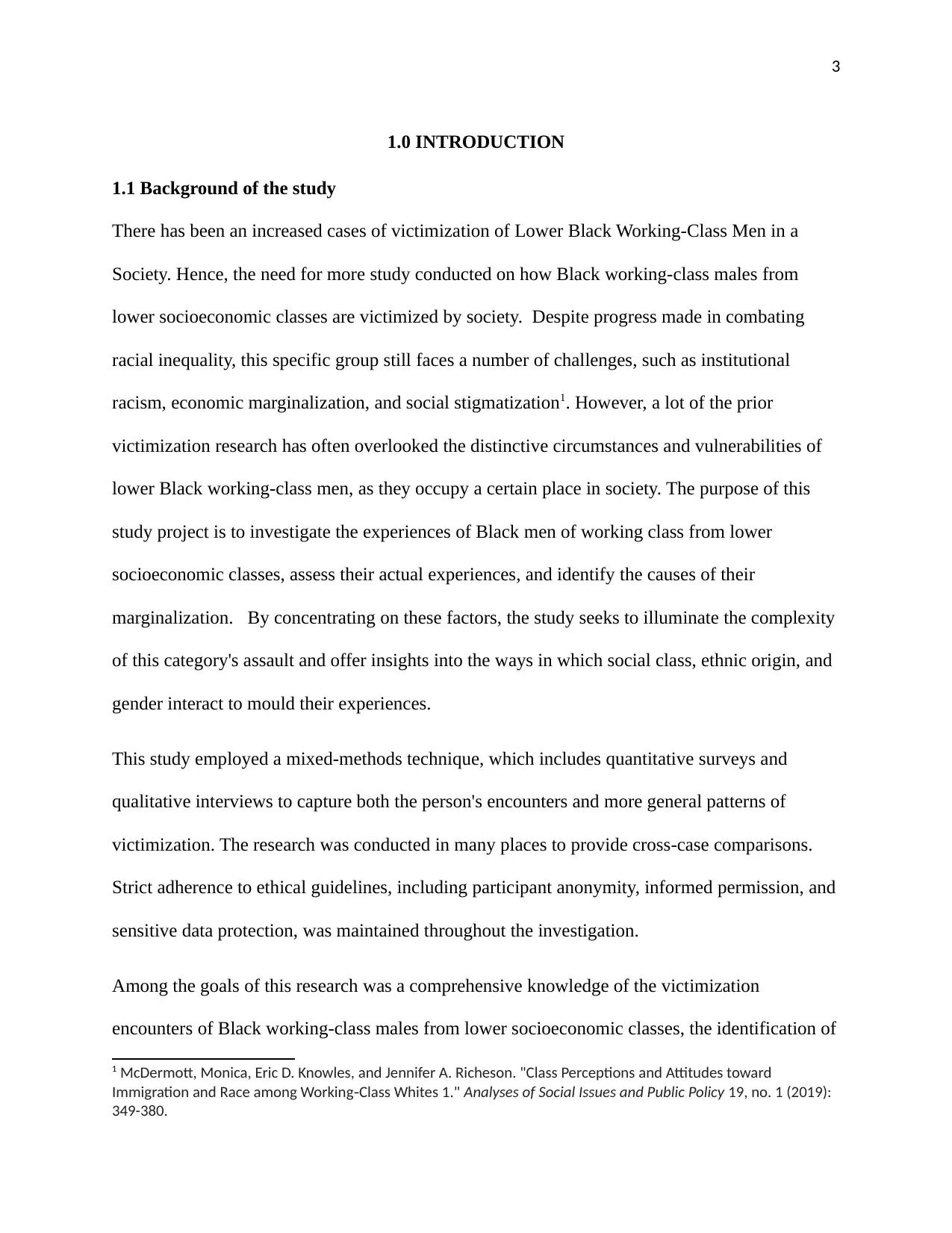
3
1.0 INTRODUCTION
1.1 Background of the study
There has been an increased cases of victimization of Lower Black Working-Class Men in a
Society. Hence, the need for more study conducted on how Black working-class males from
lower socioeconomic classes are victimized by society. Despite progress made in combating
racial inequality, this specific group still faces a number of challenges, such as institutional
racism, economic marginalization, and social stigmatization1. However, a lot of the prior
victimization research has often overlooked the distinctive circumstances and vulnerabilities of
lower Black working-class men, as they occupy a certain place in society. The purpose of this
study project is to investigate the experiences of Black men of working class from lower
socioeconomic classes, assess their actual experiences, and identify the causes of their
marginalization. By concentrating on these factors, the study seeks to illuminate the complexity
of this category's assault and offer insights into the ways in which social class, ethnic origin, and
gender interact to mould their experiences.
This study employed a mixed-methods technique, which includes quantitative surveys and
qualitative interviews to capture both the person's encounters and more general patterns of
victimization. The research was conducted in many places to provide cross-case comparisons.
Strict adherence to ethical guidelines, including participant anonymity, informed permission, and
sensitive data protection, was maintained throughout the investigation.
Among the goals of this research was a comprehensive knowledge of the victimization
encounters of Black working-class males from lower socioeconomic classes, the identification of
1 McDermott, Monica, Eric D. Knowles, and Jennifer A. Richeson. "Class Perceptions and Attitudes toward
Immigration and Race among Working Class Whites 1."‐ Analyses of Social Issues and Public Policy 19, no. 1 (2019):
349-380.
1.0 INTRODUCTION
1.1 Background of the study
There has been an increased cases of victimization of Lower Black Working-Class Men in a
Society. Hence, the need for more study conducted on how Black working-class males from
lower socioeconomic classes are victimized by society. Despite progress made in combating
racial inequality, this specific group still faces a number of challenges, such as institutional
racism, economic marginalization, and social stigmatization1. However, a lot of the prior
victimization research has often overlooked the distinctive circumstances and vulnerabilities of
lower Black working-class men, as they occupy a certain place in society. The purpose of this
study project is to investigate the experiences of Black men of working class from lower
socioeconomic classes, assess their actual experiences, and identify the causes of their
marginalization. By concentrating on these factors, the study seeks to illuminate the complexity
of this category's assault and offer insights into the ways in which social class, ethnic origin, and
gender interact to mould their experiences.
This study employed a mixed-methods technique, which includes quantitative surveys and
qualitative interviews to capture both the person's encounters and more general patterns of
victimization. The research was conducted in many places to provide cross-case comparisons.
Strict adherence to ethical guidelines, including participant anonymity, informed permission, and
sensitive data protection, was maintained throughout the investigation.
Among the goals of this research was a comprehensive knowledge of the victimization
encounters of Black working-class males from lower socioeconomic classes, the identification of
1 McDermott, Monica, Eric D. Knowles, and Jennifer A. Richeson. "Class Perceptions and Attitudes toward
Immigration and Race among Working Class Whites 1."‐ Analyses of Social Issues and Public Policy 19, no. 1 (2019):
349-380.
⊘ This is a preview!⊘
Do you want full access?
Subscribe today to unlock all pages.

Trusted by 1+ million students worldwide
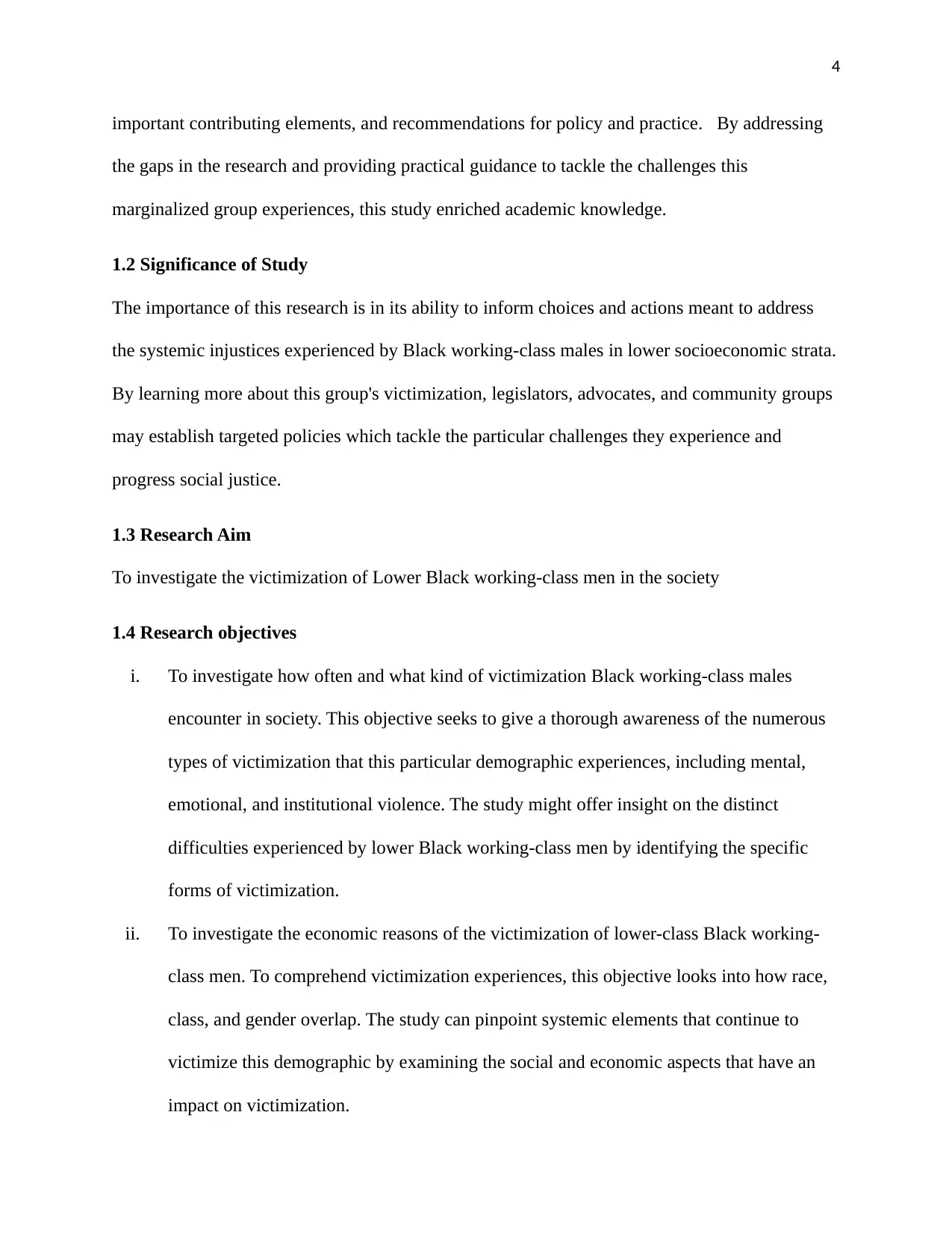
4
important contributing elements, and recommendations for policy and practice. By addressing
the gaps in the research and providing practical guidance to tackle the challenges this
marginalized group experiences, this study enriched academic knowledge.
1.2 Significance of Study
The importance of this research is in its ability to inform choices and actions meant to address
the systemic injustices experienced by Black working-class males in lower socioeconomic strata.
By learning more about this group's victimization, legislators, advocates, and community groups
may establish targeted policies which tackle the particular challenges they experience and
progress social justice.
1.3 Research Aim
To investigate the victimization of Lower Black working-class men in the society
1.4 Research objectives
i. To investigate how often and what kind of victimization Black working-class males
encounter in society. This objective seeks to give a thorough awareness of the numerous
types of victimization that this particular demographic experiences, including mental,
emotional, and institutional violence. The study might offer insight on the distinct
difficulties experienced by lower Black working-class men by identifying the specific
forms of victimization.
ii. To investigate the economic reasons of the victimization of lower-class Black working-
class men. To comprehend victimization experiences, this objective looks into how race,
class, and gender overlap. The study can pinpoint systemic elements that continue to
victimize this demographic by examining the social and economic aspects that have an
impact on victimization.
important contributing elements, and recommendations for policy and practice. By addressing
the gaps in the research and providing practical guidance to tackle the challenges this
marginalized group experiences, this study enriched academic knowledge.
1.2 Significance of Study
The importance of this research is in its ability to inform choices and actions meant to address
the systemic injustices experienced by Black working-class males in lower socioeconomic strata.
By learning more about this group's victimization, legislators, advocates, and community groups
may establish targeted policies which tackle the particular challenges they experience and
progress social justice.
1.3 Research Aim
To investigate the victimization of Lower Black working-class men in the society
1.4 Research objectives
i. To investigate how often and what kind of victimization Black working-class males
encounter in society. This objective seeks to give a thorough awareness of the numerous
types of victimization that this particular demographic experiences, including mental,
emotional, and institutional violence. The study might offer insight on the distinct
difficulties experienced by lower Black working-class men by identifying the specific
forms of victimization.
ii. To investigate the economic reasons of the victimization of lower-class Black working-
class men. To comprehend victimization experiences, this objective looks into how race,
class, and gender overlap. The study can pinpoint systemic elements that continue to
victimize this demographic by examining the social and economic aspects that have an
impact on victimization.
Paraphrase This Document
Need a fresh take? Get an instant paraphrase of this document with our AI Paraphraser
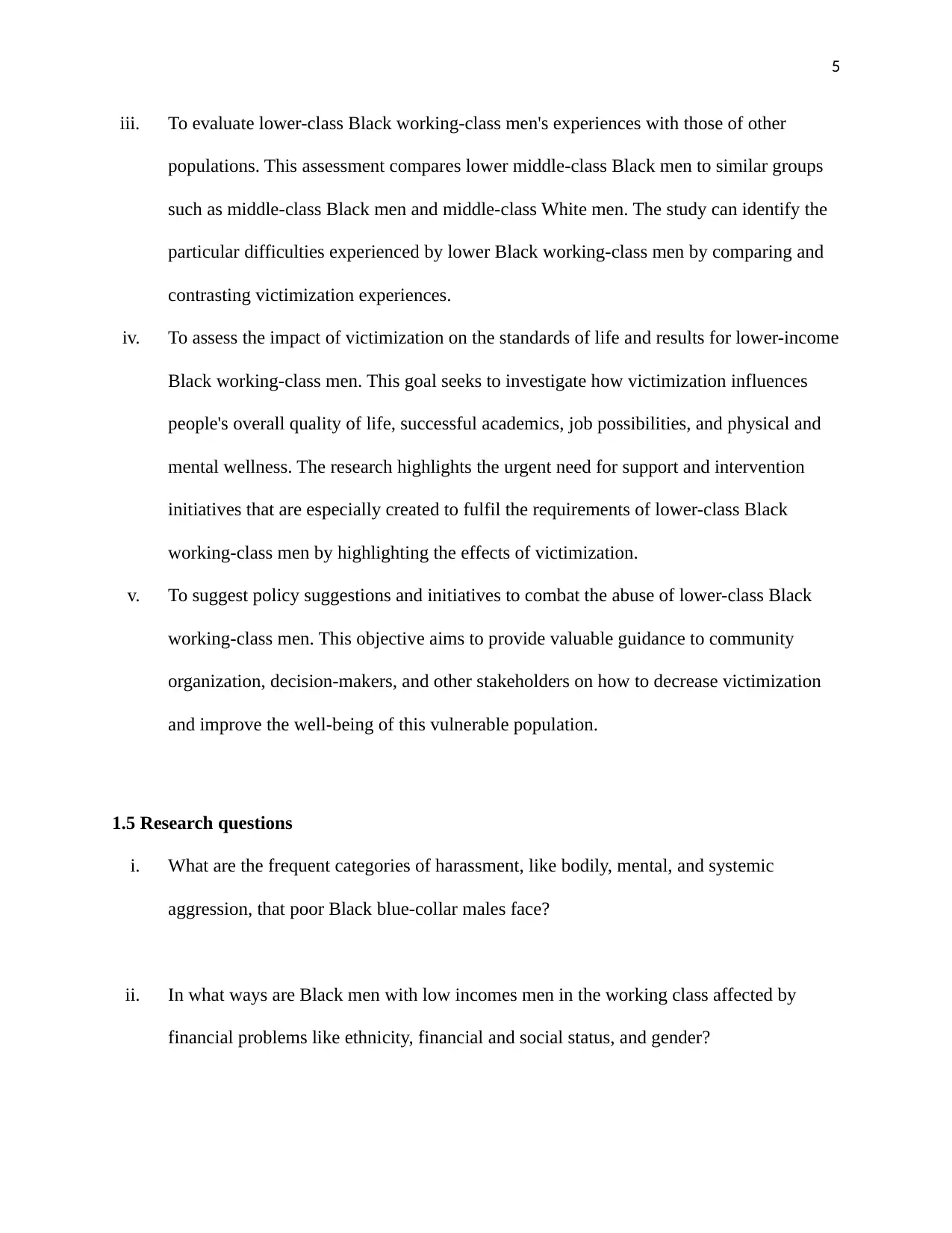
5
iii. To evaluate lower-class Black working-class men's experiences with those of other
populations. This assessment compares lower middle-class Black men to similar groups
such as middle-class Black men and middle-class White men. The study can identify the
particular difficulties experienced by lower Black working-class men by comparing and
contrasting victimization experiences.
iv. To assess the impact of victimization on the standards of life and results for lower-income
Black working-class men. This goal seeks to investigate how victimization influences
people's overall quality of life, successful academics, job possibilities, and physical and
mental wellness. The research highlights the urgent need for support and intervention
initiatives that are especially created to fulfil the requirements of lower-class Black
working-class men by highlighting the effects of victimization.
v. To suggest policy suggestions and initiatives to combat the abuse of lower-class Black
working-class men. This objective aims to provide valuable guidance to community
organization, decision-makers, and other stakeholders on how to decrease victimization
and improve the well-being of this vulnerable population.
1.5 Research questions
i. What are the frequent categories of harassment, like bodily, mental, and systemic
aggression, that poor Black blue-collar males face?
ii. In what ways are Black men with low incomes men in the working class affected by
financial problems like ethnicity, financial and social status, and gender?
iii. To evaluate lower-class Black working-class men's experiences with those of other
populations. This assessment compares lower middle-class Black men to similar groups
such as middle-class Black men and middle-class White men. The study can identify the
particular difficulties experienced by lower Black working-class men by comparing and
contrasting victimization experiences.
iv. To assess the impact of victimization on the standards of life and results for lower-income
Black working-class men. This goal seeks to investigate how victimization influences
people's overall quality of life, successful academics, job possibilities, and physical and
mental wellness. The research highlights the urgent need for support and intervention
initiatives that are especially created to fulfil the requirements of lower-class Black
working-class men by highlighting the effects of victimization.
v. To suggest policy suggestions and initiatives to combat the abuse of lower-class Black
working-class men. This objective aims to provide valuable guidance to community
organization, decision-makers, and other stakeholders on how to decrease victimization
and improve the well-being of this vulnerable population.
1.5 Research questions
i. What are the frequent categories of harassment, like bodily, mental, and systemic
aggression, that poor Black blue-collar males face?
ii. In what ways are Black men with low incomes men in the working class affected by
financial problems like ethnicity, financial and social status, and gender?
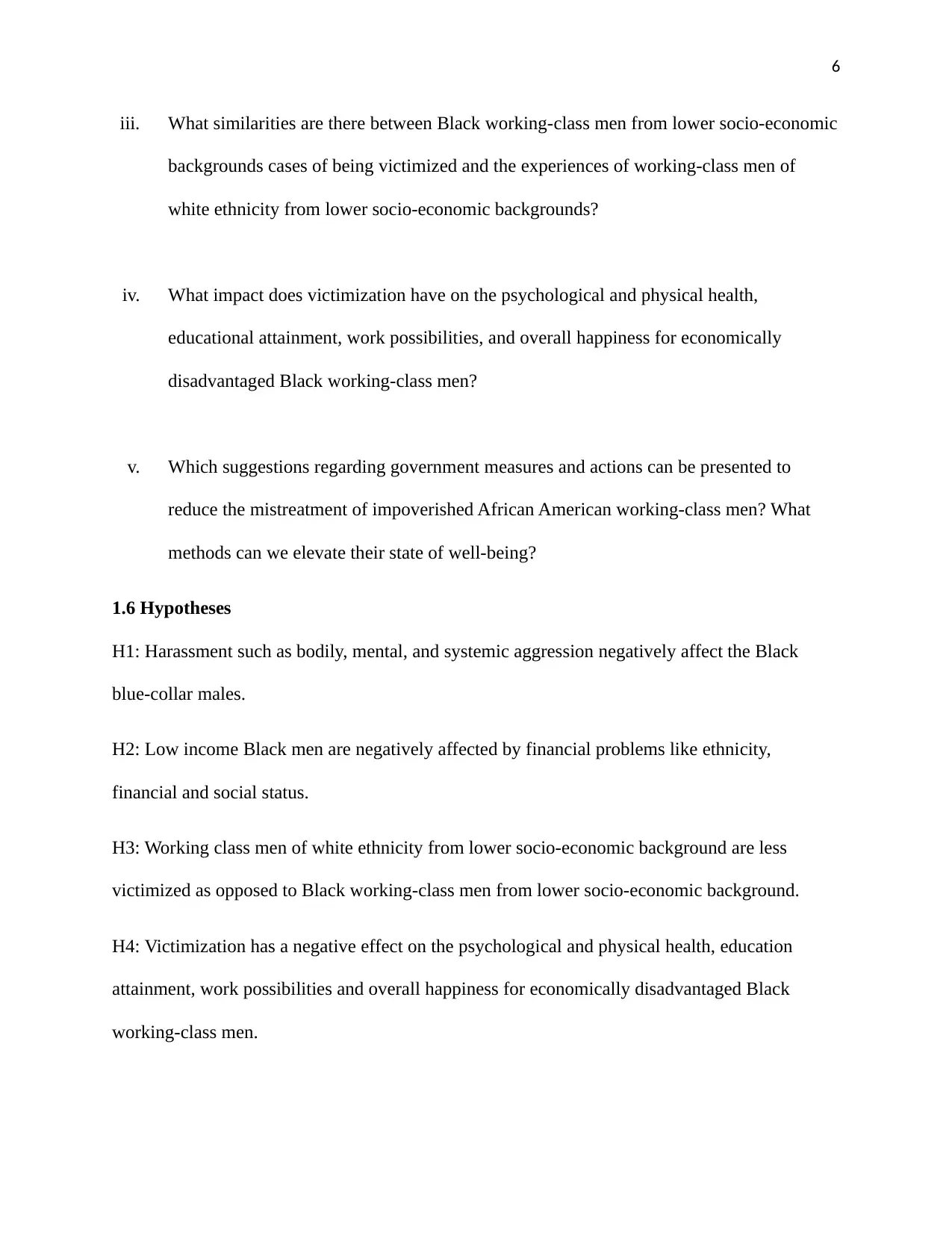
6
iii. What similarities are there between Black working-class men from lower socio-economic
backgrounds cases of being victimized and the experiences of working-class men of
white ethnicity from lower socio-economic backgrounds?
iv. What impact does victimization have on the psychological and physical health,
educational attainment, work possibilities, and overall happiness for economically
disadvantaged Black working-class men?
v. Which suggestions regarding government measures and actions can be presented to
reduce the mistreatment of impoverished African American working-class men? What
methods can we elevate their state of well-being?
1.6 Hypotheses
H1: Harassment such as bodily, mental, and systemic aggression negatively affect the Black
blue-collar males.
H2: Low income Black men are negatively affected by financial problems like ethnicity,
financial and social status.
H3: Working class men of white ethnicity from lower socio-economic background are less
victimized as opposed to Black working-class men from lower socio-economic background.
H4: Victimization has a negative effect on the psychological and physical health, education
attainment, work possibilities and overall happiness for economically disadvantaged Black
working-class men.
iii. What similarities are there between Black working-class men from lower socio-economic
backgrounds cases of being victimized and the experiences of working-class men of
white ethnicity from lower socio-economic backgrounds?
iv. What impact does victimization have on the psychological and physical health,
educational attainment, work possibilities, and overall happiness for economically
disadvantaged Black working-class men?
v. Which suggestions regarding government measures and actions can be presented to
reduce the mistreatment of impoverished African American working-class men? What
methods can we elevate their state of well-being?
1.6 Hypotheses
H1: Harassment such as bodily, mental, and systemic aggression negatively affect the Black
blue-collar males.
H2: Low income Black men are negatively affected by financial problems like ethnicity,
financial and social status.
H3: Working class men of white ethnicity from lower socio-economic background are less
victimized as opposed to Black working-class men from lower socio-economic background.
H4: Victimization has a negative effect on the psychological and physical health, education
attainment, work possibilities and overall happiness for economically disadvantaged Black
working-class men.
⊘ This is a preview!⊘
Do you want full access?
Subscribe today to unlock all pages.

Trusted by 1+ million students worldwide

7
H5: Coming up with good policies and promoting equity and social justice has a positive
influence in reducing the mistreatment of impoverished African American working-class men.
1.7 Conceptual Framework
The framework shows the relationship between the dependent and independent variable. The
parameter that is impacted by the factor that is independent is known as the dependent variable2.
On the other hand, independent variables are those that have the potential to influence changes in
the variable that is dependent and may have a positive or negative relationship with it.
2 Aspan, Henry, Iskandar Muda Sipayung, Ade Putri Muharrami, and Husni Muharram Ritonga. "The Effect of Halal
Label, Halal Awarness, Product Price, and Brand Image to the Purchasing Decision on Cosmetic Products (Case
Study on Consumers of Sari Ayu Martha Tilaar in Binjai City)." International Journal of Global Sustainability 1, no. 1
(2017): 55-66.
H5: Coming up with good policies and promoting equity and social justice has a positive
influence in reducing the mistreatment of impoverished African American working-class men.
1.7 Conceptual Framework
The framework shows the relationship between the dependent and independent variable. The
parameter that is impacted by the factor that is independent is known as the dependent variable2.
On the other hand, independent variables are those that have the potential to influence changes in
the variable that is dependent and may have a positive or negative relationship with it.
2 Aspan, Henry, Iskandar Muda Sipayung, Ade Putri Muharrami, and Husni Muharram Ritonga. "The Effect of Halal
Label, Halal Awarness, Product Price, and Brand Image to the Purchasing Decision on Cosmetic Products (Case
Study on Consumers of Sari Ayu Martha Tilaar in Binjai City)." International Journal of Global Sustainability 1, no. 1
(2017): 55-66.
Paraphrase This Document
Need a fresh take? Get an instant paraphrase of this document with our AI Paraphraser

8
2.0 LITERATURE REVIEW
2.1 Introduction
Research on the complex and urgent issue of inequality in the society against African American
working-class men from lower socioeconomic strata needs to be done. The examination of this
literature focuses on the many forms of violence that African American working-class males who
are socially marginalized endure, as well as the underlying causes and contributing variables. It
also looks into how it affects their financial and mental health in comparison to other social and
economic groups and how effective the present legal and social systems are at managing this
issue.
2.2 Types of Victimization
Investigators have highlighted the many types of victimization that black working-class guys
from lower socioeconomic classes experience. Particularly impacted by pervasive issues like
discrimination based on race and police brutality is this community. They frequently experience
increased surveillance, harassment, and biased acts from law enforcement. They begin to feel
less included in the community and less safe as a result of this. It is confirmed that “…males are
victims of the brute power of white patriarchy, which can be seen to be enforced by police
killings of Black men…3” This depicts harassment victimization experienced by the Black men
in the hands of the police.
Male black laborers in the working class also face economic hardship and social marginalization.
They also experience institutional racism, by the way. They are far more probable to experience
prejudice at work, lack of access to excellent educational opportunities, and inadequate housing4.
3 Curry, Tommy J. "Killing boogeymen: Phallicism and the misandric mischaracterizations of Black males in
theory." Res Philosophica (2018).
4 Alang, Sirry, Donna McAlpine, Ellen McCreedy, and Rachel Hardeman. "Police brutality and black health: setting
the agenda for public health scholars." American journal of public health 107, no. 5 (2017): 662-665.
2.0 LITERATURE REVIEW
2.1 Introduction
Research on the complex and urgent issue of inequality in the society against African American
working-class men from lower socioeconomic strata needs to be done. The examination of this
literature focuses on the many forms of violence that African American working-class males who
are socially marginalized endure, as well as the underlying causes and contributing variables. It
also looks into how it affects their financial and mental health in comparison to other social and
economic groups and how effective the present legal and social systems are at managing this
issue.
2.2 Types of Victimization
Investigators have highlighted the many types of victimization that black working-class guys
from lower socioeconomic classes experience. Particularly impacted by pervasive issues like
discrimination based on race and police brutality is this community. They frequently experience
increased surveillance, harassment, and biased acts from law enforcement. They begin to feel
less included in the community and less safe as a result of this. It is confirmed that “…males are
victims of the brute power of white patriarchy, which can be seen to be enforced by police
killings of Black men…3” This depicts harassment victimization experienced by the Black men
in the hands of the police.
Male black laborers in the working class also face economic hardship and social marginalization.
They also experience institutional racism, by the way. They are far more probable to experience
prejudice at work, lack of access to excellent educational opportunities, and inadequate housing4.
3 Curry, Tommy J. "Killing boogeymen: Phallicism and the misandric mischaracterizations of Black males in
theory." Res Philosophica (2018).
4 Alang, Sirry, Donna McAlpine, Ellen McCreedy, and Rachel Hardeman. "Police brutality and black health: setting
the agenda for public health scholars." American journal of public health 107, no. 5 (2017): 662-665.

9
These factors make them more vulnerable to economic exploitation that means poverty, and
limited prospects for advancement.
Welfare authorities in the Jim Crow South allowed the mistreatment of Black laborers by
enforcing "employable mother" regulations, denying payments based on ambiguous eligibility
requirements, conducting morality checks on houses, or just closing the social security office
when laborers were required in the fields5. Alongside these efforts, the police enforced the
sharecropping system by arresting Black people who were considered to be "in idleness" under
the vagrancy laws6. This often resulted in the arrest of these individuals and their forced labor
into the prison system, where chains gangs and convict-leasing programs were common.
2.3 Principal Causes and facilitating Factors
For a number of socioeconomic factors, black working-class males from lower socioeconomic
classes are often victims. In great measure, institutional racism and structural inequality maintain
their unfavorable status in society7. Unjust policies and biases in the workplace, housing
market, and educational system create barriers to their advancement socioeconomically and thus
facilitating the victimization of lower working-class Black men.
2.4 Cases, Legal Framework and Policies
It is important to examine the type of cases that has risen as result of victimization, the legal
framework and social polies that can used to combat the discriminations of the black working-
5 Soss, Joe, and Vesla Weaver. "Police are our government: Politics, political science, and the policing of race–class
subjugated communities." Annual Review of Political Science 20 (2017): 565-591.
6 Ibid
7 Elias, Amanuel, and Yin Paradies. "The costs of institutional racism and its ethical implications for
healthcare." Journal of bioethical inquiry 18 (2021): 45-58.
These factors make them more vulnerable to economic exploitation that means poverty, and
limited prospects for advancement.
Welfare authorities in the Jim Crow South allowed the mistreatment of Black laborers by
enforcing "employable mother" regulations, denying payments based on ambiguous eligibility
requirements, conducting morality checks on houses, or just closing the social security office
when laborers were required in the fields5. Alongside these efforts, the police enforced the
sharecropping system by arresting Black people who were considered to be "in idleness" under
the vagrancy laws6. This often resulted in the arrest of these individuals and their forced labor
into the prison system, where chains gangs and convict-leasing programs were common.
2.3 Principal Causes and facilitating Factors
For a number of socioeconomic factors, black working-class males from lower socioeconomic
classes are often victims. In great measure, institutional racism and structural inequality maintain
their unfavorable status in society7. Unjust policies and biases in the workplace, housing
market, and educational system create barriers to their advancement socioeconomically and thus
facilitating the victimization of lower working-class Black men.
2.4 Cases, Legal Framework and Policies
It is important to examine the type of cases that has risen as result of victimization, the legal
framework and social polies that can used to combat the discriminations of the black working-
5 Soss, Joe, and Vesla Weaver. "Police are our government: Politics, political science, and the policing of race–class
subjugated communities." Annual Review of Political Science 20 (2017): 565-591.
6 Ibid
7 Elias, Amanuel, and Yin Paradies. "The costs of institutional racism and its ethical implications for
healthcare." Journal of bioethical inquiry 18 (2021): 45-58.
⊘ This is a preview!⊘
Do you want full access?
Subscribe today to unlock all pages.

Trusted by 1+ million students worldwide

10
class men. Prior research has underscored the shortcomings within criminal justice systems,
stating that they often perpetuate racial prejudices and fail to adequately safeguard this group8.
This makes them more vulnerable to victimization.
The UK has been dealing with these instances for a number of years. The Employment Tribunal
(ET) ruling from 2021 in the matter of Sithirapathy v. PSI CRO UK Ltd. and others is one of the
latest judgement9. The judgement was associated with cases such as the lawsuit concerned
opinions related to working hour rules, unlawful and unjust expulsion, harassment, and other
equivalent acts. The decision of the judge concluded that there was unlawful harassment.
Secondly, there is Department for Work and Pensions v Thompson [2003] UKEAT
0254_03_2711. Here, the Sex Discrimination Act 1975 was used deliver the ruling as it had the
provision for work discrimination. The Act's Section 6 outlines the situations that indicate
discrimination in the workplace is prohibited10. It is widely accepted that discrimination against
Mr. Thompson may only be deemed illegal if it results in his being put in danger of a "detriment"
as defined by section 6(2)(b).
Moreover, it is against the law to act unfairly against safeguarded groups in the workplace in the
UK since they are protected from discrimination. The essential objective and universal obligation
of establishing equality of opportunities and eradicating prejudice is stated in the EqA
Introductory Text. By consolidating the laws formerly found in other pieces of government
legislation, Race Relations Act (RRA) 1976, Equal Pay Act (EPA) 1970, Disability
Discrimination Act of 1995, and Sex Discrimination Act (SDA) 1975, the Act streamlines and
harmonizes the legal backdrop to the problem11. The EqA serves as the basis for UK law.
8 Kálmán, Botond. "Discrimination at workplace–legal approach in UK and in Hungary." (2022).
9 Sithirapathy v PSI CRO UK Ltd and others 2021.
10 Sex Discrimination Act 1975
11 Ibid
class men. Prior research has underscored the shortcomings within criminal justice systems,
stating that they often perpetuate racial prejudices and fail to adequately safeguard this group8.
This makes them more vulnerable to victimization.
The UK has been dealing with these instances for a number of years. The Employment Tribunal
(ET) ruling from 2021 in the matter of Sithirapathy v. PSI CRO UK Ltd. and others is one of the
latest judgement9. The judgement was associated with cases such as the lawsuit concerned
opinions related to working hour rules, unlawful and unjust expulsion, harassment, and other
equivalent acts. The decision of the judge concluded that there was unlawful harassment.
Secondly, there is Department for Work and Pensions v Thompson [2003] UKEAT
0254_03_2711. Here, the Sex Discrimination Act 1975 was used deliver the ruling as it had the
provision for work discrimination. The Act's Section 6 outlines the situations that indicate
discrimination in the workplace is prohibited10. It is widely accepted that discrimination against
Mr. Thompson may only be deemed illegal if it results in his being put in danger of a "detriment"
as defined by section 6(2)(b).
Moreover, it is against the law to act unfairly against safeguarded groups in the workplace in the
UK since they are protected from discrimination. The essential objective and universal obligation
of establishing equality of opportunities and eradicating prejudice is stated in the EqA
Introductory Text. By consolidating the laws formerly found in other pieces of government
legislation, Race Relations Act (RRA) 1976, Equal Pay Act (EPA) 1970, Disability
Discrimination Act of 1995, and Sex Discrimination Act (SDA) 1975, the Act streamlines and
harmonizes the legal backdrop to the problem11. The EqA serves as the basis for UK law.
8 Kálmán, Botond. "Discrimination at workplace–legal approach in UK and in Hungary." (2022).
9 Sithirapathy v PSI CRO UK Ltd and others 2021.
10 Sex Discrimination Act 1975
11 Ibid
Paraphrase This Document
Need a fresh take? Get an instant paraphrase of this document with our AI Paraphraser

11
Therefore, the establishment of effective initiatives and policies is required in order to address
the victimization that the marginalized population experiences. This can be achieved through
identifying the different types of victimization, understanding the underlying causes, analyzing
its impacts on contentment and socioeconomic status, carrying out corresponding analyses, and
assessing the social policies and legal framework that are currently in place.
Therefore, the establishment of effective initiatives and policies is required in order to address
the victimization that the marginalized population experiences. This can be achieved through
identifying the different types of victimization, understanding the underlying causes, analyzing
its impacts on contentment and socioeconomic status, carrying out corresponding analyses, and
assessing the social policies and legal framework that are currently in place.

12
3.0 RESEARCH METHODOLOGY
3.1 Introduction
This chapter elaborates on the use of mixed method, quantitative and qualitative techniques,
techniques used for sampling, calculation of sample size, data collection instruments, procedure
followed to collect data, the software used, and ethical consideration.
3.2 Qualitative Method
In addition to an emphasis on assault, the study's qualitative component looked at the opinions
and interactions of black working-class men from lower social classes12. The study included
interviews with semi-structured questions and thematic analysis as two qualitative research
methodologies to get valuable data on the participants' real-life experiences. The main
justification for employing qualitative approaches is the aim to have a complete understanding of
the many and complex circumstances faced by lower class Black working-class males. For this
study, semi-structured interviews served as the main method of data gathering. In-person
interviews were done to build rapport and delve more into the experiences of the individuals. In
order to maintain uniformity throughout interviews and provide flexibility for the exploration of
emerging topics, a guide to interviews was created.
12 Walker, Charlie. "Remaking a “failed” masculinity: working-class young men, breadwinning, and morality in
contemporary Russia." Social Politics: International Studies in Gender, State & Society 29, no. 4 (2022): 1474-1496.
3.0 RESEARCH METHODOLOGY
3.1 Introduction
This chapter elaborates on the use of mixed method, quantitative and qualitative techniques,
techniques used for sampling, calculation of sample size, data collection instruments, procedure
followed to collect data, the software used, and ethical consideration.
3.2 Qualitative Method
In addition to an emphasis on assault, the study's qualitative component looked at the opinions
and interactions of black working-class men from lower social classes12. The study included
interviews with semi-structured questions and thematic analysis as two qualitative research
methodologies to get valuable data on the participants' real-life experiences. The main
justification for employing qualitative approaches is the aim to have a complete understanding of
the many and complex circumstances faced by lower class Black working-class males. For this
study, semi-structured interviews served as the main method of data gathering. In-person
interviews were done to build rapport and delve more into the experiences of the individuals. In
order to maintain uniformity throughout interviews and provide flexibility for the exploration of
emerging topics, a guide to interviews was created.
12 Walker, Charlie. "Remaking a “failed” masculinity: working-class young men, breadwinning, and morality in
contemporary Russia." Social Politics: International Studies in Gender, State & Society 29, no. 4 (2022): 1474-1496.
⊘ This is a preview!⊘
Do you want full access?
Subscribe today to unlock all pages.

Trusted by 1+ million students worldwide
1 out of 39
Related Documents
Your All-in-One AI-Powered Toolkit for Academic Success.
+13062052269
info@desklib.com
Available 24*7 on WhatsApp / Email
![[object Object]](/_next/static/media/star-bottom.7253800d.svg)
Unlock your academic potential
Copyright © 2020–2025 A2Z Services. All Rights Reserved. Developed and managed by ZUCOL.




